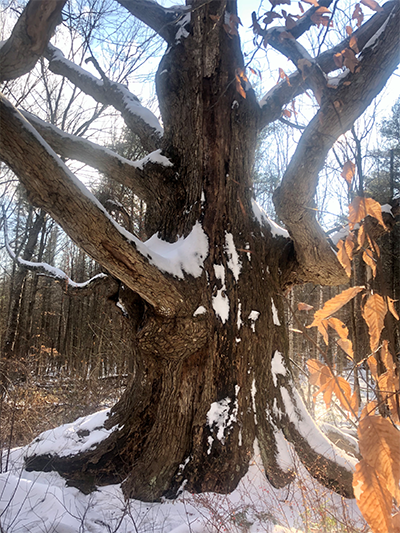Woods Wise Wire
For over 30 years, the Forest Operations Notification (FONS) system has been paper-based. Landowners and managers submit paper copies to the Maine Forest Service (MFS); data is entered by hand; acknowledgment letters printed and mailed; FONS filed, etc. Repeat the process with amendments. Then paper copies of landowner harvest reports are sent out at the end of the year. More paper, more data entry, more filing. That’s all about to change.
Starting in January 2021, FONS will become Forest Online Resource Tool (FOResT), and it will be all online. Landowners, Designated Agents, Foresters, and Loggers will need to create individual accounts in FOResT to participate in harvest notifications.
 Some important features include mapping of Forest Operations Notification activities, digital signatures, automatic notification of all parties named on a notification, and automated, end of year landowner reports.
“The Maine Forest Service has a rich history of ensuring that Maine's forests continue to provide a full range of benefits to present and future generations of Maine people,” Maine Forest Service Director Patty Cormier observed. “Part of that effort is maintaining a notification database for harvest activity in Maine. This database helps the Maine Forest Service develop and advocate for activities that encourage the sound, long-term management of Maine’s forests, and to provide reliable, timely and accurate information about the forest resource. This new online harvest notification system will provide for ease of access, and ready information for forest practitioners. We at the Maine Forest Service are happy to offer this online service for your convenience.”
MFS currently is testing the system with a small set of users to identify and fix glitches before the system goes fully live. We will continue to offer additional information, including how-to videos, as the year progresses.
For now, you don’t need to do anything. Just be aware that paper FONS are going away soon.

If you know your way around the Maine woods you can likely tell a beech from a white pine from a red oak in your sleep. But what about a ginkgo, a hawthorn or a crabapple? You are unlikely to see a white pine in a tree grate in front of your favorite market, but I bet you’ve seen Japanese tree lilacs or honeylocusts. The trees in our front yards and in our downtowns experience a whole different range of conditions than our forest trees do: sun scald, salt buildup, compressed soils and lots of pet waste – and those conditions require species that are better equipped to handle those stressors than our forest trees. We’ve created a quick and easy Maine Urban Tree Key to print or save to your mobile device so you can identify that tree in the village green. Special thanks to the Wisconsin Department of Natural Resources, Division of Forestry for sharing their template. We hope this helps you to enjoy the trees you find in your neighborhood.
Download Maine Urban Tree ID Guide (PDF | 3.5 MB)
|
Since 1968, the Maine Forest Service has published a list of the largest known specimens of native and naturalized trees in Maine. Only one specimen can claim its title as state champion since the first edition.
The white ash (Fraxinus americana), located in Waterford dominates over all other nominations in the category, and while it does show signs of its age and sheer size, endures as state champion. First nominated at a time when records were maintained with the use of transfer paper, and when now retired forester Richard Morse was headquartered at the Hebron Demonstration Forest; the white ash, which is located at what is known as the “Blackgaurd” section of Waterford has a commanding presence. In normal settings, even one of its scaffold branches would be considered a big tree on its own.
To determine if a tree is a champion, the Maine Forest Service gives each tree a score based on a formula that adds circumference in inches, height in feet, and ¼ of the crown spread in feet. The Waterford white ash has a circumference of 245” (dbh = 80”), a height of 91’, and an average crown spread of 76’ for a total point value of 362.
 |
At the time of nomination, the owner was informed as to the importance of preservation of such an exemplary specimen. While listing with the Maine Register of Big Trees comes with some inherent protection, doing so in no way guarantees that trees will be maintained by the owner, or by the state. In many cases trees listed on the Maine Register of Big Trees do eventually succumb to the wear and tear of supporting a large canopy, and must be removed or return to the soil. In other more unfortunate cases, trees have been removed to make way for development, or simply are unwanted. While we will work with landowners to find other solutions to removal, in some cases the result is the same. Fortunately for the white ash in Waterford, the location is well protected, and the landowners remain committed to keep this marvelous tree healthy.
The tree is located on private property. In order to visit this tree, you must first obtain landowner permission. For more information, you can contact the Maine Forest Service.
For more information on Maine’s Register of Big Trees and to receive a copy of the new Register when available, please contact Jan Santerre, Big Tree Coordinator, at the Maine Forest Service, 22 State House Station, Augusta, ME 04333 or call 1-800-367-0223. The Register can also be viewed by visiting the Project Canopy website: http://www.projectcanopy.me
|